In a word, no they aren’t any good. As usual, cheap doesn’t equal good, and in this case the cheapo clones are a total waste of money. Read on for the details!
I’ve been looking into using a cheap Chinese clone Honda GX35 engine to drive an automotive alternator as a portable battery charging & power unit. These engines are available very cheaply on eBay, aimed at the mini-bike/go-kart market.
For those not in the know, the Honda GX25/35 4-strokes are strimmer-type engines that traditionally were always of 2-stroke construction. Honda worked out how to have a wet-sump engine without the need to keep the engine always in the “upright” position. They do not require mixing of oil into the fuel for lubrication as 2-strokes do, so should be much cleaner running.
So far I’ve had two of these cheap engines, as the first one died after only 4 hours run time, having entirely lost compression. At the time the engine was idling, no load, having been started from cold only a few minutes before. Having checked the valve clearances to make sure a valve wasn’t being held partially open, I deduced that the cause was broken piston rings. This engine was replaced by the seller, so I didn’t get a chance to pull it to bits to find out, but I decided to do a full teardown on the replacement to see where the cloners have cut corners.
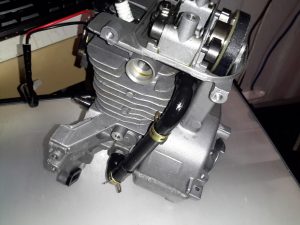
I’ve already stripped off the ancillary components: exhaust, carburettor, fuel tank, cowlings, as these parts are standard to any strimmer engine. The large black hose here is the oil return feed back to the rocker cover from the crankcase. The oiling system in these engines is rather clever. The main engine block is made of light alloy, probably some permutation of Aluminium. There is much flashing left behind between the cylinder fins from the die-casting process, and not a single engine manufacturer’s logo anywhere. (From what I’ve read, the genuine Honda ones have their logo on the side of the crankcase).
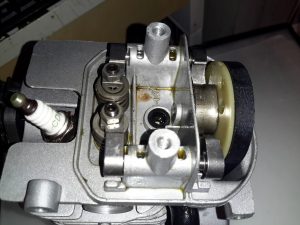
Here’s the top of the engine with valves, rockers & camshaft. All the valve gear up here, minus the valves themselves & springs, are manufactured from sintered steel, there are no proper “bearings”, the steel shafts just run in the aluminium castings. The cam gear is of plastic, with the sintered steel cam pressed into place. The cam also has the bearing surface for the pin that the whole assembly rotates on. The timing belt runs in the oil & is supposed to last the life of the engine, and while I’d believe that in the original Honda, I certainly wouldn’t in this engine. The black grommet is the opening of the oil return gallery.
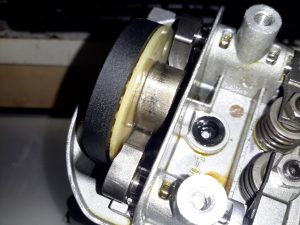
Here’s the cam on the back of the plastic pulley. A single cam is used for both intake & exhaust valves for space & simplicity.
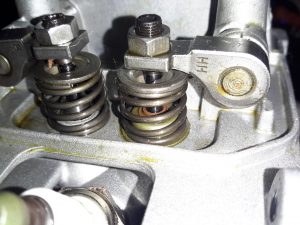
Just visible under the intake valve spring is a simple stem seal, to hopefully prevent oil being sucked down the valve guide into the cylinder by intake vacuum. Running these cheap engines proves this seal to be ineffective, as they blow about as much blue oil smoke as a 2-stroke when they’re started cold. 😉
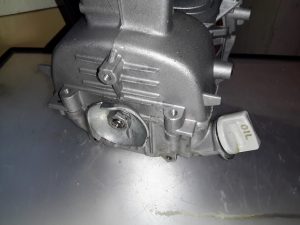
The starter side is where the oil sump is located on these engines, along with the dipstick.
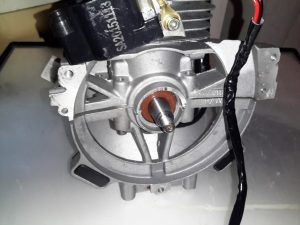
The flywheel end of the engine is the usual fare for small engines. Ignition is provided by a magneto, with a magnet in the flywheel. This is no different from the 2-stroke versions. As these ignitions fire on every revolution of the crankshaft, the spark plug fires both on compression, igniting the fuel for normal operation, and again into the exhaust stroke, where the spark is wasted.
One thing I have noticed about these engines is an almost total lack of cooling air coming through the cowling over the cylinder cooling fins. Plenty was flowing over the exhaust silencer side, I believe bad housing design would be what causes this problem. A lack of cooling certainly wouldn’t help engine longevity!
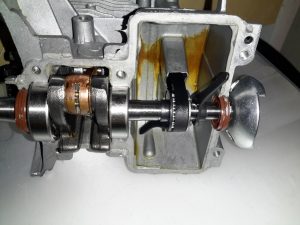
Separating the bottom of the engine was a little difficult, as there is a significant bead of sealant used instead of a gasket. Inside the sump of the engine are a pair of paddles, which stir up the oil into a mist. As the piston moves in the cylinder, it acts as a pump, creating alternating pulses of pressure & vacuum in the crankcase. Oil mist flows through a drilling in the crank from the sump, into the crankcase where it (hopefully) lubricates the bearings & the cylinder wall. Incidentally, the only main bearings are on the crankcase – the far end of the shaft that carries the oil paddles & timing belt is just flapping in the breeze, the only support being the oil seal in the outer housing. The crank itself isn’t hardened – a file easily removes metal from all parts that I could get at. The big end journal pin might be, but these cranks are pressed together so I can’t access that part.

The oil mist feeds into the crankcase through this hollow section of shaft, there’s a drilling next to the timing belt pulley to connect the two spaces together.
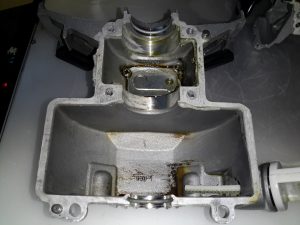
The lower crankcase is just a simple die casting, there’s a check valve at the bottom under the crankshaft to transfer oil to the rocker cover, through the rubber tube on the outside of the engine. After the oil reaches the rocker box, it condenses & returns to the sump via the timing belt cavity.
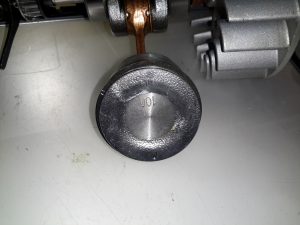
Removing the crankshaft from the engine block gives me a look at the piston. The factory couldn’t even be arsed to machine the crown, it’s still got the rough finish from the hot-forging press. This bad finish will pick up much carbon from combustion, and would probably cause detonation once enough had accumulated to become incandescent in the heat of combustion. Only the centre is machined, just enough for them to stamp a number on.
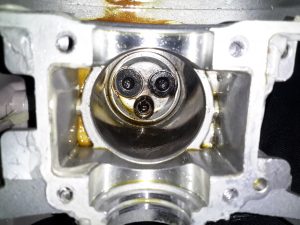
A look up the cylinder bore shows the valves in the cylinder head. These engines, like their 2-stroke cousins have a single casting instead of a separate block & head, so getting at the valves is a little more of a pain. The cylinder bore itself is a cast-in iron liner and it’s totally smooth – like a mirror finish. There’s not a single sign of a crosshatch pattern from honing. If the first engine that died on me was the same – I’d be surprised if it wasn’t, this could easily cause ring breakage. The usual crosshatch pattern the cylinder hone produces holds oil, to better help lubricate the piston & rings. Without sufficient lubrication, the rings will overheat & expand far enough to close the end gap. Once this happens they will break.

Finally, here’s the valves with their springs removed from the cylinder. These are the smallest poppet valves I’ve ever seen, a British penny is provided for scale.
In all, these engines share many components with the older 2-stroke versions. The basic crankshaft & connecting rod setup is the same as I’ve seen in many old 2-strokes previous, the addition of the rather ingenious oiling system by Honda is what makes these tiny 4-strokes possible. I definitely won’t be trusting these very cheap copies in any of my projects, reliability is questionable at the least. The apparent lack of cooling air flow over the cylinder from the flywheel fan is concerning, along with the corner-cutting on the cylinder finishing process & piston crown, presumably to reduce factory costs.

Thank you for an interesting review of this engine. For experimental purposes, do you think it is possible to separate the cylinder and cylinder head by using for example a closed loop diamond string or some other tool and then bolt them back together in the usual way?
Hi Kim,
I seriously doubt this would be possible, there’s no extra metal around the cylinder bore that could be threaded for head bolts, these engines are engineered for cheapness and as a result, there’s little extra in the castings. The oiling system is also unique on these engines, so it would be very complex to get a gasket to seal all the bits properly.
I can’t honestly think of a reason you’d need a separate head on one of these either. Please elaborate 😉
Thanks for reading,
de 2E0GXE
This guy’s post is very old and outdated. He claims that two engines failed but mentioned that they may have had issues before he ran them using. I’ve been using the 38 cc four stroke clone motor on a motorized bicycle that will propel it to 34 mph in less than 10 secondsand it has over 5000 miles on it and I’ve had no issues
what brand is the motor brian
Thanks for the reply and I get your points. My ideas are also pretty far out so I understand why you don’t see the point. It’s a long story but basically I just want to use the bottom end up to and including the connecting rod 🙂 But I would need something to bolt on to after that so your comments are also valid for my case.
Thanks again, Kim
Because of your well-detailed presentation, I have been shown that purchasing a GX35 clone/copy/imitation would be a mistake.
My remaining concern is about a true Honda-made engine. Do you know if the same weaknesses found in the clone would exist in an actual Honda-made engine ?
I ask because I was informed by a business associate, that does a good deal of trading in asia, that both the true Honda and the clone are being manufactured in the same manufacturing complex near Bangkok, Thailand.
Retoldpro,
The copy engines are manufactured in China, The Honda engines are manufactured/assembled in Thailand. Two different countries.
As The Engineer pointed out in his article, whilst the copy engines are similar, they are not the same. Due to higher costs (importing of tooling, machinery and materials, higher cost of labour), it would not make economic sense to manufacture the copy engines in Thailand.
Copy Honda parts (from China) are available in Thailand but they are easy to distinguish from the ‘real deal’ due to printing and grammatical errors on the packaging and the generally poorer (looking) quality of the parts. These are aftermarket parts and Honda would go ballistic if these copy parts were to find their way into their assembly/manufacturing plants.
Does your comment re clone quality of GX35,apply to the clone cylinder using genuine Honda internal parts?
2022, bought what was supposed to be a genuine Honda GX35 about 2 yrs ago here in VN, soon after the market was flooded with Thai copies, at almost 1/2 the price I paid!!!!!, but I think mine is also Thai????, probably done about 100 hrs, now no comp. It started to lose power the last couple of times i used it, then I used it for about an hour, and it just wouldn’t start again. I also have a Honda Winner, ( made in Thailand ), 150 cc DOHC, done 31k, still going well, but I had to replace the expensive fuel pump around 20k.
Hi.
To be honest, this clone appears to be the same as a genuine Honda GX35. Maybe the piston is better machined on the Honda?
Now in 2023, I just bought a clone for my RC Plane conversion project. I paid $AUD 140 shipped.
For my purpose, it’s a perfect engine. RC panes live short lives, because they crash. On average I will fly them for 3 flights a weekend for about 10 minutes at most. It has been totally stripped of all cowling material and spinning a large prop assure adequate air flow, and cooling will never be a problem. I am grateful that I can buy a quiet 4 stroke engine for the price I paid and the power it produces is adequate for my needs. It chugs along at 1/2 trhottle or less most of the time. The fact that they used as little material as they can is a bonus as it means it’s light. Its the cheapest 4 stroke model aero engine in it’s class. (35cc 4 stroke).
I own three of these motors one is on a ice drill one is on a log splitter and the other is on a bicycle that pushes it to 28 mph I’ve had no issues in 2 years I run them in all kinds of temperatures I’ve had Honda motors that had issues within a few hours these clone motors take a licking and keep on ticking change the oil every 10 hours of operation 10cents a oz can’t go wrong
I want one to fit on a bicycle for long distance touring. If I change the oil frequently at the start, will this solve the over heated rings issue?
I bought a new lawn mower B&S engine. After 22 mins running the oil looked like a glitter ball. 2nd oil change ( 5 hrs + and 3 rd after a year of use had ok oil condition)
Put one GX35 clone on a small quad it runs well and never misses a beat not bad for $115 AUD.
I’ve just seen this ‘Honda’ strimmer on sale through Costco for £71.99. Naturally I was drawn to the product which was well-presented and lauded for it’s ‘Honda’ attributes. However, as a guy with 30yrs+ experience of using quality garden machinery I am not going to pursue this ‘amazingly’ cheap offer. I was put off by the ticking down digital clock in background that gave me under 7mins to buy product or lose out – why I can’t have a few days to do some research etc before buying was alarming and I cut off from ad there and then. I’ve used an Echo X-series high torque srm2620tes strimmer for several years now and the unquestionably-top quality Japanese engineering comes with the price tag. I purchased mine 4yrs ago at £330 – and what a superb investment that has been. This model is now priced at around £500 and I would have no hesitation paying this amount for another should the need arise. I would stick with the old adage when items like the Honda gx35 appear at ‘knock-down’ price: If it seems too good to be true, then it probably is. Generally, I think you get what you pay for with more or less any product and this is in my opinion a good rule of thumb & barometer. Many years ago I bought a Chinese chainsaw with a big cc and bar for only £99. I used it once and the whole crankcase cracked like a 6.0 richter earthquake. I was actually rolling around laughing at the sheer garbage-level of the thing & the utterly non-functional components. I then found a warning label – in my own head which said: ‘Imitation only,not to be used as functional chainsaw’.